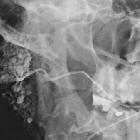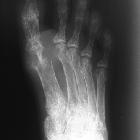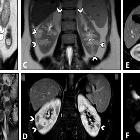Pulmonary hyalinising granuloma






Pulmonary hyalinising granulomas are rare, non-infectious, benign fibrosing lesions of the lung that can, sometimes, mimic pulmonary malignancy.
Clinical presentation
Most patients (~ 75% ) with pulmonary hyalinising granulomas can be symptomatic with it. Commonly reported symptoms include vague chest-related symptoms such as shortness of breath; cough; fatigue; low-grade fever; pleuritic chest pain ; or rarely, hemoptysis. Up to 25% of patients are symptom-free.
Pathology
Histological features can bear a striking resemblance to fibrosing mediastinitis . The center of the lesion consists of hyaline collagen arranged in a distinctive pattern of concentric lamellae sometimes with focal calcification or ossification.
Their exact etiology is not well known, but they may be caused by an exaggerated immune response.
They are probably related to a chronic immune reaction to either endogenous or exogenous antigens or infectious agents such as H. capsulatum or Mycobacterium organisms. They are thought to occur in individuals predisposed to marked scar formation.
Commonly associated with fibrosing mediastinitis and retroperitoneal fibrosis .
Radiographic features
Plain radiograph
They may be seen as slow-growing solitary or, more often, multiple well-defined nodules on radiographs .
CT
Pulmonary hyalinizing granulomas can appear as well-marginated solitary or multiple nodules varying from a few millimeters to 15 cm in size. There may be associated calcification which is usually focal central and irregular .
History and etymology
It was first described by P Engleman et.al in 1977 .
Differential diagnosis
Siehe auch:

 Assoziationen und Differentialdiagnosen zu pulmonale hyaline Granulomatose:
Assoziationen und Differentialdiagnosen zu pulmonale hyaline Granulomatose:



